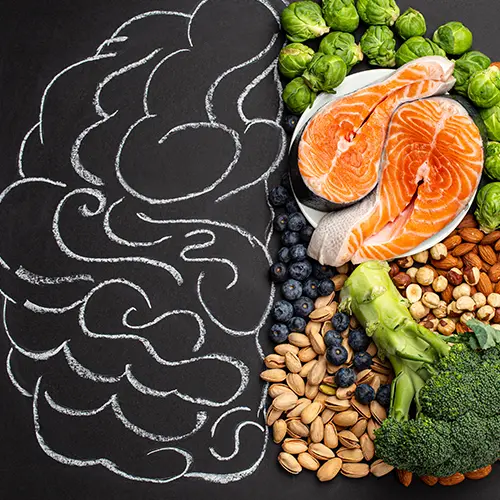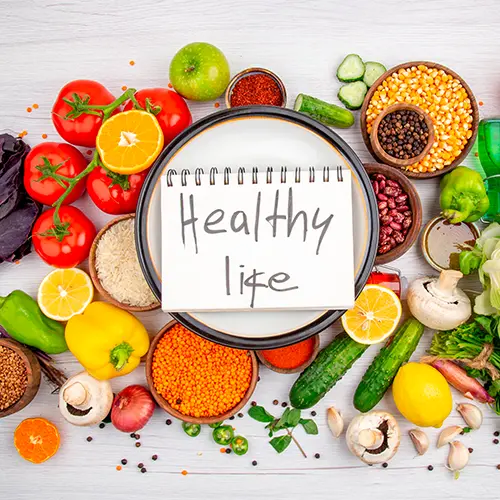Table of Contents
Fiber is a vital component of a healthy diet, often overshadowed by other nutrients but equally important. In this blog post, we explore the top 20 fiber-rich foods that not only contribute to a well-rounded diet but also offer numerous health benefits.
From aiding digestion to maintaining blood sugar levels and supporting heart health, the role of fiber in our daily nutrition is indispensable.
These selected foods, ranging from fruits and vegetables to grains and legumes, are not only packed with fiber but also come with a host of vitamins, minerals, and antioxidants.
Whether you're looking to improve your digestive health, manage your weight, or simply eat healthier, incorporating these fiber-rich foods into your meals can make a significant difference.
Join us as we delve into the world of fiber-rich foods and discover how easy and delicious it can be to boost your fiber intake.
1. Lentils
Lentils are small, lens-shaped legumes known for their high fiber content and rich nutritional profile.
They're an excellent source of protein, particularly for plant-based diets, and contain essential nutrients like iron, folate, and manganese. Lentils are versatile, cook quickly, and are used in a variety of cuisines worldwide.
2. Black Beans
Black beans, a staple in Latin American cuisine, are prized for their dense, meaty texture.
These small, shiny legumes are a nutritional powerhouse, offering a high fiber content alongside significant protein.
They are also rich in antioxidants, vitamins, and minerals such as iron and magnesium.
Black beans are commonly used in soups, stews, salads, and as a filling in burritos and tacos, making them a versatile ingredient in both vegetarian and meat-based dishes.
3. Chickpeas
Chickpeas, also known as garbanzo beans, are round, beige legumes renowned for their versatility and nutritional benefits. Rich in fiber and protein, they support digestive health and can aid in weight management.
Chickpeas are also a good source of key nutrients like iron, folate, and phosphorus.
They are a staple in Middle Eastern and Indian cuisines, used in dishes like hummus, falafel, and chana masala.
Their nutty flavor and firm texture make them a popular ingredient in salads, stews, and snack foods.
4. Oats
Oats are a nutritious whole grain known for their health benefits and versatility. They are an excellent source of soluble fiber, particularly beta-glucan, which aids in lowering cholesterol and stabilizing blood sugar levels.
Rich in antioxidants and essential nutrients like manganese, phosphorus, and magnesium, oats are a heart-healthy choice.
Commonly consumed as oatmeal or porridge, they are also used in baking, granola, and smoothies.
Their ability to absorb liquids and become creamy makes them ideal for a variety of dishes, both sweet and savory.
5. Barley
Barley, one of the oldest and most versatile grains, is highly nutritious and rich in fiber, particularly the soluble type that aids in digestion and blood sugar regulation.
It's a good source of several vitamins and minerals, including selenium, manganese, and niacin.
Barley's chewy texture and nutty flavor make it a popular choice in soups, stews, salads, and as a rice alternative.
It's available in various forms like hulled barley (with only the outermost hull removed) and pearl barley (polished and quicker to cook), each offering distinct culinary uses and health benefits.
6. Chia Seeds
Chia seeds are tiny, nutrient-dense seeds known for their high fiber content, particularly soluble fiber.
Native to Mexico and Guatemala, they've gained popularity globally as a superfood. Rich in omega-3 fatty acids, antioxidants, and essential minerals like calcium, magnesium, and phosphorus, chia seeds offer various health benefits, including improved digestive health and heart health.
When soaked, they absorb water and form a gel-like consistency, making them ideal for puddings and smoothies.
Their subtle nutty flavor allows for versatile use in baking, as a topping for yogurt and salads, or as an egg substitute in vegan cooking.
7. Raspberries
Raspberries are a highly nutritious, fiber-rich fruit known for their sweet-tart flavor and vibrant red color.
They stand out for their high fiber content, particularly beneficial for digestive health. These berries are also packed with antioxidants, vitamins C and K, and manganese, contributing to overall health and helping to fight inflammation.
Low in calories yet high in fiber, raspberries are an excellent choice for weight management and can be enjoyed fresh, frozen, or in various dishes.
They add a burst of flavor to salads, desserts, yogurt, and smoothies, and are equally delightful when eaten on their own.
8. Pears
Pears are a sweet, juicy fruit renowned for their high fiber content, particularly in their skin.
They are an excellent source of both soluble and insoluble fiber, aiding in digestive health and regularity. Pears also provide a good amount of essential nutrients like vitamin C, vitamin K, and potassium.
Their soft, buttery texture makes them a delightful addition to both sweet and savory dishes. They can be enjoyed fresh, cooked, or baked, and are often used in salads, desserts, jams, and as a complement to cheeses.
The variety of pear types, from Bartlett to Anjou, offers a range of flavors and textures for culinary exploration.
9. Avocado
Avocado is a unique fruit, distinguished by its rich, creamy texture and healthy fats, primarily monounsaturated fat. It's highly valued for its high fiber content, contributing to digestive health and satiety.
Avocados are also packed with essential nutrients, including potassium, which is key for heart health, and vitamins K, C, E, and various B vitamins.
Their versatility in the kitchen is notable; they can be used in salads, sandwiches, smoothies, and famously, as guacamole.
Avocados not only enhance flavor but also aid in the absorption of fat-soluble vitamins from other foods, making them a nutritious and delicious addition to any meal.
10. Artichokes
Artichokes are a unique and flavorful vegetable, known for their high fiber content, which is among the highest in vegetables.
They are particularly rich in inulin, a type of prebiotic fiber that supports gut health. Artichokes are also a good source of vitamins C and K, folate, magnesium, and antioxidants like cynarin and silymarin, which are beneficial for liver health and digestion.
Typically, the fleshy part of the leaves and the heart are eaten, both offering a subtle, slightly nutty flavor.
Artichokes can be steamed, boiled, grilled, or baked, and are often used in dips, salads, pasta dishes, and as a healthy side dish.
Their unique taste and texture make them a delightful addition to a variety of culinary creations.
11. Green Peas
Green peas, small yet nutrient-rich, are an excellent source of dietary fiber, which aids in digestion and helps maintain a healthy gut.
They're also packed with plant-based protein, making them a great choice for vegetarians and vegans.
Rich in vitamins A, C, K, and several B vitamins, as well as minerals like iron, manganese, and phosphorus, green peas are beneficial for overall health.
Despite their small size, they're surprisingly high in fiber and protein. Versatile in the kitchen, they can be used in a variety of dishes, including soups, stews, salads, and as a healthy side.
Their sweet, slightly starchy taste adds a delightful flavor and texture to meals.
12. Broccoli
Broccoli, a cruciferous vegetable, is highly regarded for its rich fiber content and dense nutritional profile.
It's an excellent source of both soluble and insoluble fiber, promoting digestive health and regularity.
Broccoli is also packed with vitamins C and K, and provides minerals like iron, potassium, and magnesium. It contains potent antioxidants, including sulforaphane, which is known for its potential cancer-fighting properties.
This versatile vegetable can be enjoyed raw, steamed, roasted, or stir-fried, making it a valuable addition to a variety of dishes. Its distinct flavor and texture make it popular in salads, casseroles, and as a nutritious side dish.
Broccoli's health benefits and culinary versatility make it a staple in a balanced diet.
13. Brussels Sprouts
Brussels sprouts, a member of the cruciferous vegetable family, are renowned for their high fiber content and robust nutrient profile.
These small, cabbage-like vegetables are packed with both soluble and insoluble fiber, aiding in digestive health and regularity.
They are also an excellent source of vitamins K and C, and contain good amounts of folate, manganese, and antioxidants like kaempferol, which have anti-inflammatory properties.
Brussels sprouts can be cooked in various ways including roasting, steaming, and sautéing, which bring out their natural sweetness and reduce their inherent bitterness.
They are commonly used in side dishes, salads, and as an accompaniment to meat dishes, offering a combination of health benefits and a hearty flavor.
14. Almonds
Almonds are a highly nutritious nut, well-known for their substantial fiber content. They are an excellent source of healthy fats, primarily monounsaturated fats, which are beneficial for heart health.
Almonds also provide a good amount of protein, making them a great snack option for sustained energy.
Rich in vitamin E, magnesium, and antioxidants, they contribute to overall health, including skin health and blood sugar control.
Their versatility in the kitchen is notable; they can be enjoyed raw or roasted as a snack, sliced or slivered in salads and desserts, or ground into almond flour for baking.
Almonds' crunchy texture and slightly sweet flavor make them a popular and healthy addition to various culinary creations.
15. Quinoa
Quinoa, often referred to as a "super grain," is actually a seed that boasts a high fiber content and a complete protein profile, containing all nine essential amino acids.
It's a fantastic choice for vegetarians and vegans. Quinoa is also rich in vitamins and minerals like iron, magnesium, B vitamins, and manganese.
Its antioxidant properties, particularly from flavonoids like quercetin and kaempferol, contribute to its health benefits.
Quinoa's versatility in the kitchen is notable; it can be used as a base in salads, as a substitute for rice or pasta, in baking, or even in breakfast dishes. Its nutty flavor and fluffy texture make it a popular and nutritious alternative to traditional grains.
16. Sweet Potatoes
Sweet potatoes are a nutritious root vegetable known for their high fiber content, particularly when the skin is left on. They are an excellent source of vitamins A and C, manganese, and several other vitamins and minerals.
Their natural sweetness and starchy texture make them a favorite in a variety of dishes.
Rich in antioxidants, particularly beta-carotene, sweet potatoes offer health benefits such as improved eye health and enhanced immune function.
They can be baked, roasted, mashed, or used in soups, stews, and even desserts. Their versatility and delicious flavor make sweet potatoes a valuable addition to a healthy diet, appealing to both savory and sweet preferences.
17. Apples
Apples are a popular and versatile fruit known for their significant fiber content, especially in the skin.
They are a good source of both soluble and insoluble fiber, aiding in digestive health and cholesterol management.
Apples are also rich in vitamins, particularly vitamin C, and contain a variety of antioxidants like quercetin, which contribute to overall health and may reduce the risk of chronic diseases.
Their natural sweetness and crisp texture make them a convenient snack and a flavorful addition to a range of dishes, from salads and cereals to baked goods and sauces.
Eating apples regularly can be a delicious way to support heart health, manage weight, and maintain healthy blood sugar levels.
18. Whole Wheat Pasta
Whole wheat pasta is a healthier alternative to traditional white pasta, made from whole grain wheat that includes the bran, germ, and endosperm.
This type of pasta is significantly higher in fiber, which aids in digestion and provides a feeling of fullness.
It's also richer in nutrients compared to refined pasta, offering more B vitamins, iron, magnesium, and several other minerals.
The presence of whole grains in whole wheat pasta contributes to its benefits in maintaining heart health and stabilizing blood sugar levels.
It has a denser, chewier texture and a nuttier flavor than regular pasta, and works well in a variety of dishes, from traditional Italian recipes to contemporary global cuisines.
Incorporating whole wheat pasta into meals is an easy way to increase dietary fiber intake while enjoying a familiar and versatile dish.
19. Pearled Barley
Pearled barley, a refined form of barley where the outer husk and bran layers are removed, is a popular grain known for its chewy texture and mild, nutty flavor.
Although it's less nutrient-dense than whole grain barley due to the removal of the outer layers, pearled barley still offers a good amount of dietary fiber, particularly soluble fiber, which is beneficial for digestive health and cholesterol management.
It's also a source of nutrients including manganese, selenium, and B vitamins.
Pearled barley is versatile in the kitchen and can be used in a wide range of dishes, such as soups, stews, salads, and risottos.
Its ability to absorb flavors makes it a great ingredient for both savory and sweet recipes, providing a healthful and satisfying addition to meals.
20. Flaxseeds
Flaxseeds, also known as linseeds, are small oil seeds known for their high fiber content, particularly rich in both soluble and insoluble fiber.
They are an excellent source of omega-3 fatty acids, specifically alpha-linolenic acid (ALA), which is beneficial for heart health.
Flaxseeds are also rich in lignans, a type of phytoestrogen with antioxidant properties, and are a good source of minerals like magnesium and manganese.
They can benefit digestive health, help in lowering cholesterol, and may have a role in reducing the risk of certain cancers.
Ground flaxseeds are often added to smoothies, oatmeal, yogurt, and baked goods for a nutritional boost, while whole flaxseeds can be used as a crunchy topping for salads and cereals. Their subtle nutty flavor enhances the taste profile of various dishes.
F.A.Q
What is dietary fiber?
Dietary fiber refers to plant-based carbohydrates that cannot be digested in the small intestine. It plays a crucial role in maintaining digestive health and comes in two forms: soluble and insoluble fiber.
Why is fiber important for health?
Fiber is essential for several reasons: it aids in digestion, helps regulate blood sugar levels, supports heart health, and can aid in weight management. It also helps in reducing the risk of certain diseases like diabetes, heart disease, and some forms of cancer.
How much fiber should I consume daily?
The recommended daily intake of fiber varies. Generally, women should aim for about 25 grams per day, while men should target about 38 grams. However, these needs can vary based on individual health conditions and dietary requirements.
What are the best sources of dietary fiber?
Fruits, vegetables, whole grains, legumes, nuts, and seeds are excellent sources of dietary fiber. Foods like berries, apples, carrots, broccoli, lentils, and oats are particularly high in fiber.
Can you get too much fiber?
While it's rare, excessive fiber intake can lead to digestive discomfort, such as bloating, gas, and constipation. It's important to increase fiber intake gradually and ensure adequate hydration.
How can I increase my fiber intake?
Start by incorporating more fruits, vegetables, whole grains, and legumes into your diet. Replace refined grains with whole grains, snack on nuts and seeds, and choose high-fiber fruits and vegetables.
Are there fiber supplements? Should I consider them?
Fiber supplements are available, but it's best to get fiber from whole foods for additional nutrients and health benefits. Supplements can be considered in certain cases, but it's advisable to consult with a healthcare provider first.
Can fiber benefit weight loss?
Yes, high-fiber foods tend to be more filling, which can help reduce overall calorie intake and aid in weight loss. Fiber also helps regulate blood sugar levels, which can reduce cravings and improve weight management.
Are there any risks associated with a high-fiber diet?
For most people, a high-fiber diet is beneficial and not associated with serious risks. However, it's important to increase fiber intake gradually to allow the digestive system to adjust.
Do children need fiber?
Yes, children also need fiber. The amount varies by age and gender, but including fiber-rich foods in a child's diet is important for their overall digestive health and well-being.




















